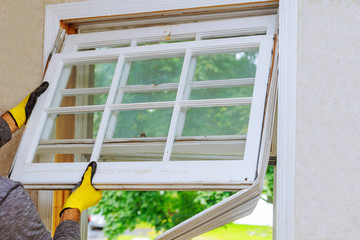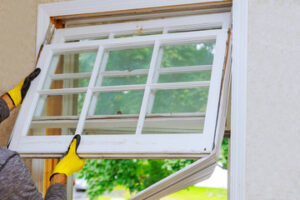Window Replacement Rockville MD is an excellent investment that provides long-term benefits for your home. It’s important to choose windows with a high energy efficiency rating and durable materials that can stand up to the elements.

It’s also helpful to understand the different parts of a window. This will help you better communicate with contractors and minimize confusion.
The right windows are critical to a home’s energy efficiency, insulation and aesthetics. But navigating the many styles, configurations and add-ons available can be overwhelming.
New replacement windows are designed with advanced materials and technologies that improve insulation and reduce energy costs. They are also easier to operate and provide improved security.
Window replacement offers homeowners the opportunity to upgrade to double- or triple-pane windows, which significantly increase energy efficiency. These windows are constructed with thicker glass and insulated frames to block out heat and cold. They can also be equipped with argon or low-E glass to further reduce energy losses and control solar gain.
In addition to reducing energy costs, replacement windows can enhance the comfort of a home by improving ventilation and lowering noise levels. They can also increase a home’s resale value, and require less annual maintenance than older windows.
When choosing replacement windows, be sure to consider how the style will affect a home’s curb appeal. Some popular options include bay or bow windows, awning windows and casement windows. Each type of window can add a unique appearance to a house and may have different installation requirements.
Before installing new windows, it’s important to understand how they are rated for energy efficiency. Windows are rated by their R-value and U-factor, which measure how well they insulate. The lower the R-value and U-factor, the more efficient the window.
There are two main types of window replacement: full frame and retrofit. A full-frame installation involves removing the entire window frame and sash and replacing it with an energy-efficient unit. This is often used for older homes with significant damage to the frame and sash or when there are structural issues that need to be addressed.
A retrofit installation uses existing window frames and trim, so it is less expensive than a full-frame replacement. This method involves removing only the window sash and installing an energy-efficient window into the frame. This is sometimes referred to as a pocket or insert installation.
Homeowners should consider replacement windows if they notice drafts, difficult operation, visible damage or condensation between the panes of glass. In addition, homeowners who are planning a home remodel should factor in the cost of replacement windows to help minimize overall project costs.
Style
When homeowners are planning window replacement, they typically have many different style options to consider. Each type of window offers a unique benefit that can contribute to the overall functionality and appearance of the home’s interior.
It’s also important to consider the requirements for specific rooms, including privacy, ventilation and lighting. By taking these factors into consideration, homeowners can choose a window that will meet the needs of their household while enhancing its overall appeal and resale value.
The most common type of new window is the double hung, which features two operable sashes that slide up or down. This style can be customized with an extensive selection of features, including grids, interior blinds and energy-efficient glass packages.
Other window styles that can enhance the appearance of a home include bay and bow windows, which protrude from the exterior wall to provide ample natural light and panoramic views. Awning windows, which open outward from the top, are another option that allows rain and snow to slide down the glass, rather than into the interior of the home.
The style of a new window can also be customized by choosing from an assortment of frame colors, decorative glass options and hardware finishes. This allows homeowners to create a unique look that complements their existing décor and matches the overall style of the home’s exterior.
Window materials also have a significant impact on the cost of the project. Each material offers its own set of benefits and comes at a different price point. For example, vinyl windows are the most affordable option, while wood-framed windows are the most expensive.
A homeowner’s final decision often depends on the size of their existing opening, as well as any restrictions that may apply. For example, if the new window will be installed over an existing deck, it’s important to ensure that the window opens outward and does not impede traffic on the deck.
By taking into account all of the available style and configuration options, homeowners can make a confident choice that will ensure their new windows are not only beautiful but functional. The experts at RM Quality Windows & Doors can help homeowners understand the differences between various window types and find the best solution for their home improvement project. Contact us today to schedule a free consultation!
Materials
The material a window is made of and the style can have a significant impact on cost. Vinyl, fiberglass, and wood clad windows are all commonly available in a variety of styles and colors. Energy efficiency features like double- and triple-pane glass with low-emissivity coatings are likely to increase the upfront cost of a new window but can save on energy bills over time.
The best windows are built with durable materials that can withstand extreme temperatures and weather conditions, while remaining attractive. Window frames and sashes should be designed to prevent air leakage, minimize solar heat gain, and provide a good seal.
A classic choice is wood, which can be stained or painted to match the surrounding home décor. It’s an excellent choice for older homes where maintaining the existing appearance is important.
Vinyl is another durable and energy efficient option. It doesn’t expand or contract with temperature changes and is resistant to fading, blistering, flaking, and peeling. It is also less expensive than wood and comes in a wide range of colors.
Fiberglass is similar to vinyl but performs better in a wider range of temperatures and doesn’t require painting or staining. It is also a good choice for coastal regions, where harsh salty winds can deteriorate other types of materials.
Aluminum is strong and durable, but can rust in some environments. It is also not as energy efficient as vinyl or fiberglass. A newer alternative is composite, which is a mix of wood fibers and PVC polymer. It performs well in a wide range of temperatures and resists rot, mold, mildew, and insect damage.
The type of window you choose will depend on the size and style of the current opening. A full replacement window will replace the entire frame and jamb components, which requires modifications to the wall structure. An insert window fits into the existing opening without disturbing the original frame, interior trim, or exterior siding. It is a more affordable option for homeowners who want to upgrade their windows without extensive remodeling.
Installation
Window replacement improves your home’s aesthetic, but it also helps prevent drafts and energy loss. To ensure your new windows are properly installed, choose a contractor with an established track record of quality installation. A contractor with a high standard of work will take the time to assess your project, discuss any custom options you have chosen, and answer questions you may have. Additionally, they will conduct a technical measurement appointment and prepare the work area before beginning construction.
The initial assessment will begin with accurate measurements of the existing window opening. The contractor will measure the width and height of the frame at three different points: top, middle, and bottom. This will help them determine the correct size for your new window. Choosing the best possible measurements will ensure that your new windows fit properly and do not cause water infiltration or air leaks.
Once the measurements are complete, the contractor will order the new window based on your specifications. They will then remove the old window sash and hardware from the opening, taking care not to damage the surrounding wall or window frame. Once the window is removed, the work area will be cleaned and any trim or molding that needs to be replaced will be completed.
A new window should be sealed and insulated to prevent drafts and improve energy efficiency. This step is especially important if your old windows are not performing well, or if you are feeling drafts around your existing windows. In addition to sealing and insulating the new window, a caulking line will be applied around the perimeter to ensure a weatherproof seal.
A good contractor will also apply a coat of primer and paint to the trim around the window. This will protect the wood from moisture and will prevent the finish from peeling or scratching. Once the work is complete, your contractors will clean up the workspace and make sure you are familiar with your new windows and any maintenance or warranty information. If you are not home during the window installation process, be sure to leave a key with the installers or arrange for someone else to give them access to your home.




